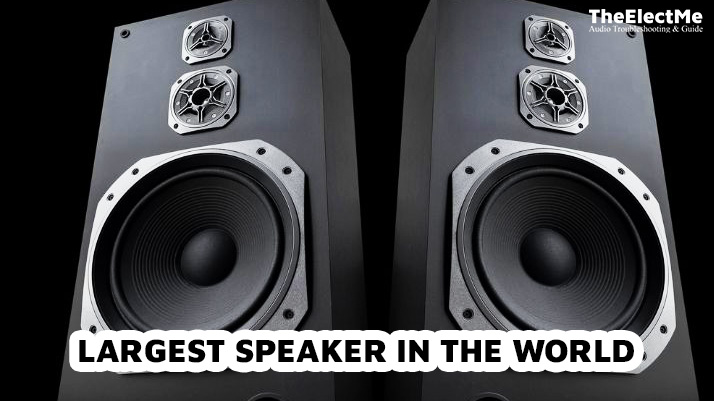Are you tired of experiencing distorted audio when listening to music or watching movies? One standard solution that many people overlook is setting up speaker delay.
Speaker delay plays a vital role in crafting an immersive sound journey. It’s that critical element that ties the audio experience together, ensuring a seamless and harmonious flow of sound. But what exactly is speaker delay? Simply put, it’s the fine-tuning of sound delivery from multiple speakers to ensure they reach the listener’s ears simultaneously.

Setting up speaker delay is essential for any sound engineer or audio enthusiast. But how exactly do you achieve this?
Whether it’s setting up a home theater, arranging a live concert, or optimizing your car audio system, these tips will help you achieve perfect speaker delay. Let’s understand the science behind speaker delay.
What Is Speaker Delay?
To fully grasp the concept of speaker delay, it’s essential to understand the basics of sound waves and their speed. Sound travels through the air at a constant speed of approximately 343 meters per second (or 1,125 feet per second) at room temperature. This means that when sound is emitted from a speaker, it takes time to reach the listener.
In a perfect scenario, sound from all speakers would reach the listener’s ears simultaneously, creating a harmonious blend of sound. However, speakers are often placed at varying distances from the listener.
Without adjustment, the sound from the closer speaker will reach the listener before the sound from the farther speaker, causing an audio misalignment known as a “phase issue.”
This is where the concept of time alignment comes in. Time alignment adjusts sound timing from each speaker for simultaneous delivery to the listener’s ears, regardless of speaker distance.
Time-Aligned Speakers and Their Role in Your PA System
Time alignment is crucial to any public address (PA) system setup. It ensures that everyone in the audience experiences high-quality, synchronized sound regardless of location.
The process involves delaying the sound from the closer speakers to match the arrival time of the sound from the farther speakers. This is achieved by adding a calculated delay to the signal feeding the more relative speakers.
Using time-aligned speakers has numerous benefits. It eliminates phase issues, ensuring a clear and crisp sound. It also creates a more balanced sound field, improving the overall audio experience for the audience. Moreover, time alignment can help reduce feedback and echo issues, enhancing clarity.
Understanding and implementing time alignment in speaker setup can significantly enhance your PA system’s quality. You can connect or remove the speaker from Sonos. How to remove a speaker from Sonos. Click the link to explore now.
After understanding the importance of speaker delay and time alignment, let’s dive into how to set it up like a pro.
Setting Up Speaker Delay: A Step-by-Step Guide
Setting up speaker delay involves a series of steps, each crucial to the result. Here’s a detailed guide on how to go about it:
Step No. 1: Measuring the Distance
The first step in setting up speaker delay is measuring the distance between the speakers and the listener’s location. Accurate measurement is critical because even slight variations can affect the sound quality.
Here are some tools and techniques you can use:
- Tape Measure: A simple tape measure can be helpful for smaller spaces. However, it may need to be more convenient and accurate for larger areas.
- String and Ruler: Use a string to span the distance from the speaker to the listening position, then measure the string length with a ruler. This method can be more accurate than a tape measure for longer distances.
- Trigonometry: If the setup is complex, you might need trigonometry to calculate the distances accurately. This could involve measuring horizontal and vertical distances separately and then using the Pythagorean theorem to determine the direct path.

Step No. 2: Using a Laser Measuring Device
A laser measuring device is an excellent tool for measuring speaker-listener distances. It provides highly accurate measurements quickly and easily.
To use one, stand at the listener’s location and point the device towards each speaker. Note down the distance displayed on the device’s screen. Repeat for each speaker in your setup.
Step No. 3: Calculating the Delay
Once you have all the distances, it’s time to calculate the delay. The formula for this is:
Delay (in milliseconds) = Distance difference (in feet) / Speed of sound (1,125 feet per second) * 1000. For example, if the distance to speaker A is 30 feet and to speaker B is 40 feet, the delay for speaker A will be:
Delay = (40 – 30) / 1,125 * 1000 = 8.89 milliseconds
Step No. 4: Adjusting the Speaker Settings
After calculating the delay, the next step is adjusting the speaker settings. Here are some tips to help you do this effectively:
- Access the Configuration Menu: Most speakers have a configuration menu that can be accessed through a physical button or dial on the speaker itself or via a software interface.
- Locate the Delay Setting: Look for a setting labeled ‘delay’ or ‘time alignment’. This is where you’ll enter the calculated delay value.
- Enter the Delay Value: Enter the calculated delay value if your speakers don’t support millisecond-level precision, round to the nearest whole number.
- Test and Fine-Tune: Play some audio and move around the listening area after setting the delay. If the sound isn’t quite right, adjust the delay settings until you get the desired sound quality.
Step No. 5: Setting Up Delayed Loudspeakers
In larger venues, you may need to use delayed loudspeakers. These are additional speakers placed farther away from the main speakers to ensure optimal sound coverage. Here’s how to set them up:
- Orient the Loudspeakers: The delayed loudspeakers should be oriented towards the farthest listeners.
- Position Appropriately: Position the loudspeakers to minimize overlap with the main speakers’ sound coverage. This will help avoid phase issues.
- Calculate and Set Delay: Measure the distance from the main speakers to the delayed loudspeakers, calculate the necessary delay, and adjust the loudspeaker settings accordingly.
This ensures the sound from all speakers reaches the audience simultaneously, providing a cohesive sound experience. You can enjoy your favorite music anywhere you can. You may listen to music under tree or under water. But how to listen music underwater?
This is a common question among music lovers who enjoy spending time in the water. Click the above link for more information.
When you follow this step, you may face different challenges requiring some adjustments. Let’s explore some common issues.

Troubleshooting Common Issues with Speaker Delay
While setting up speaker delay can significantly improve your sound system’s performance, you might encounter some issues. Here are a few common problems and their solutions:
Inconsistent Sound Quality
If the sound quality varies across different parts of the listening area, it could mean the speaker delay needs to be set correctly. Try adjusting the delay settings until the sound is consistent throughout.
Echo or Reverberation
Echo or reverberation can occur when the sound from delayed loudspeakers overlaps with the sound from the main speakers. Reposition the delayed speakers to minimize overlap or adjust their delay settings to solve this.
Sound Distortion
Many factors, including incorrect speaker delay can cause distorted sound. If adjusting the delay doesn’t solve the problem, check other settings, such as volume and equalization.
Phase Issues
If the sound seems to be coming from different directions or there’s a noticeable lack of bass, it could be due to phase issues. This often happens when the sound from different speakers arrives at other times.
Check the speaker delay settings and adjust them as necessary.
Lack of Synchronization
If a performance’s visual and audio elements are not in sync, it could be due to incorrect speaker delay. For instance, if the sound from a performer’s actions reaches the audience before or after the visual cue, it can disrupt the immersive experience. Adjust the speaker delay settings to ensure audio-visual synchronization.
If you’ve tried these solutions and are still experiencing problems, it might be time to seek professional help. A professional audio technician can diagnose and fix complex issues that are beyond the scope of basic troubleshooting.
They have specialized equipment and expertise to ensure your sound system is set up and functioning optimally.
Final Thoughts – How Do You Set Up Speaker Delay?
To conclude the blog post, speaker delay is essential to sound system setup. It ensures the audio reaches all listeners simultaneously, providing a cohesive and immersive experience. With the steps outlined in this guide, you can easily calculate and adjust speaker delay for your setup.
Here are three takeaways to remember:
- Measure the distances from speakers to listeners and use a laser measuring device for accuracy.
- Calculate the delay using the formula Distance difference (in feet) / Speed of sound (1,125 feet per second) * 1000.
- Adjust speaker settings and test to ensure optimal sound quality.
If you encounter issues while setting up speaker delay, refer to the troubleshooting guide or seek professional help. Proper setup and maintenance allow your sound system to provide exceptional audio experiences for years.



